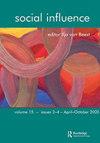帮助孩子还是大人?系统地测试儿童和成人受害者的可识别受害者效应
IF 0.6
3区 心理学
Q3 PSYCHOLOGY, SOCIAL
引用次数: 4
摘要
可识别受害人效应(IVE;帮助一个确定的受害者(而不是统计上的受害者)对儿童受害者的帮助比对成人受害者的帮助更强?在本文中,我们测试了识别受害者以及受害者是儿童还是成人对帮助动机和捐赠行为的影响。在来自不同国家的三个不同样本的研究(N = 1508)中,我们发现可识别性对我们的任何测量都没有主要影响,并且不支持IVE主要发生在儿童身上。然而,我们发现了年龄效应;与成年受害者相比,儿童受害者得到了更多的帮助(研究1a-1b),或者激发了更大的帮助动机(研究2)。本文章由计算机程序翻译,如有差异,请以英文原文为准。
Helping the child or the adult? Systematically testing the identifiable victim effect for child and adult victims
ABSTRACT Is the identifiable victim effect (IVE; helping a single identified victim more than a statistical victim) stronger for child victims than adult victims? In this paper, we test the effect of identifying a victim and whether that victim is a child or adult on helping motivation and donation behaviors. In three studies (N = 1508) with different samples from different countries, we find no main effect of identifiability on any of our measures, and no support that the IVE mainly occurs for children. However, we find an age effect; child victims receive more help (studies 1a-1b) or evoke a greater motivation to help (study 2) than adult victims.
求助全文
通过发布文献求助,成功后即可免费获取论文全文。
去求助
来源期刊

Social Influence
PSYCHOLOGY, SOCIAL-
CiteScore
1.50
自引率
0.00%
发文量
4
期刊介绍:
Social Influence is a journal that provides an integrated focus for research into this important, dynamic, and multi-disciplinary field. Topics covered include: conformity, norms, social influence tactics such as norm of reciprocity, authority, scarcity, interpersonal influence, persuasion, power, advertising, mass media effects, political persuasion, propaganda, comparative influence, compliance, minority influence, influence in groups, cultic influence, social movements, social contagions, rumors, resistance to influence, influence across cultures, and the history of influence research.
 求助内容:
求助内容: 应助结果提醒方式:
应助结果提醒方式:


